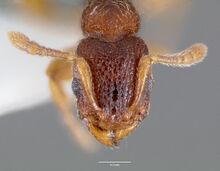Key to Vollenhovia of Japan
This worker key is based on: Terayama, M. and K. Kinomura. 1997. Taxonomic studies of Japanese Formicidae, part 3. Genus Vollenhovia Mayr. Nature and Human Activities. 2:1-8.
A tentative key to the Japanese species of Vollenhovia (workers). A workerless social parasitic species, Vollenhovia nipponica Kinomura and Yamauchi, is excluded in the following key.
Please note Vollenhovia yambaru was described in 1999, after this key was published, thus is not included here.
You may also be interested in
1
- Subpetiolar process developed; its thin lamellar wall higher than long . . . . . 2
- Subpetiolar process low: its thin lamellar wall distinctly longer than high . . . . . 4
2
return to couplet #1
- Frons with a large brown spot; larger species (HL > 0.55 mm, HW > 0.50 mm): clypeal carinae diverging anteriorly; body reddish brown . . . . . 3
- Frons without large brown spot; smaller species (HL < 0. 54 mm, HW < 0.48 mm): clypeal carinae almost parallel; body yellowish brown . . . . . Vollenhovia sakishimana
3
return to couplet #2
- Propodeal teeth present; posterodorsal corner of petiolar node convex. not forming angle in profile . . . . . Vollenhovia emeryi
- Propodeal teeth absent: posterodorsal corner of petiolar node forming angle in profile . . . . . Vollenhovia amamiana
4
return to couplet #1
- Dorsum of promesonotum with an unsculptural longitudinal band medially; postpetiole highest at posterior 1/3 in profile; posterodorsal margin of postpetiole concave in profile . . . . . Vollenhovia okinawana
- Dorsum of promesonotum coarsely punctated in most part and without unsculptured longitudinal band medially; postpetiole highest at midlength in profile; posterodorsal margin of postpetiole broadly convex in profile . . . . . Vollenhovia benzai








